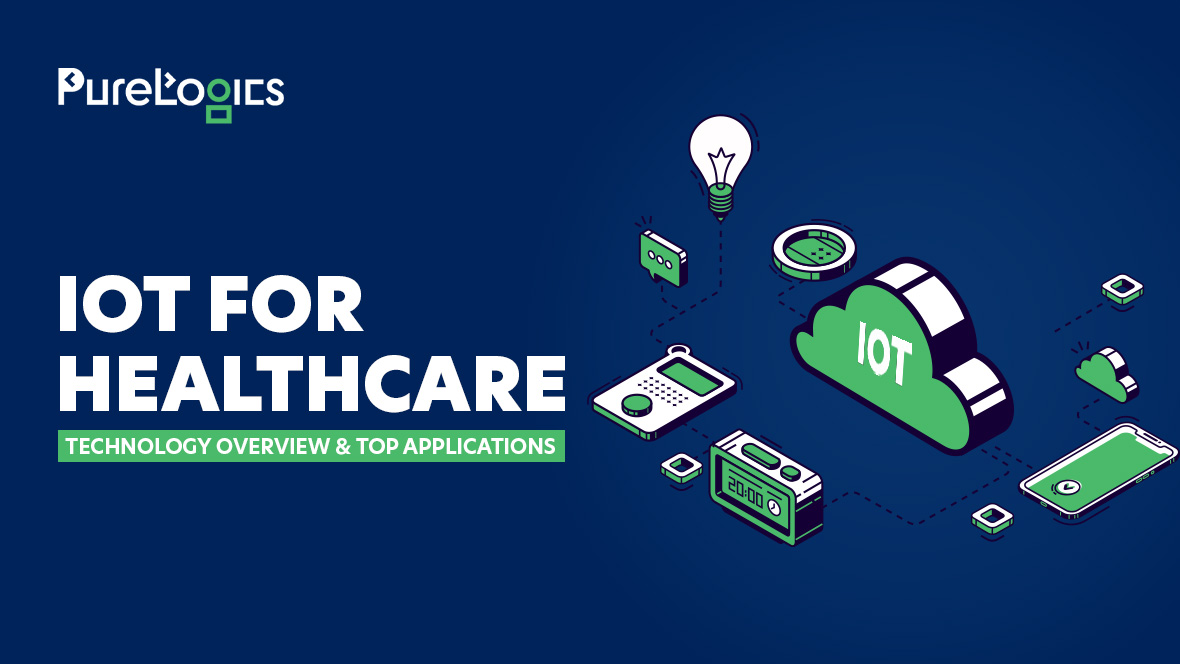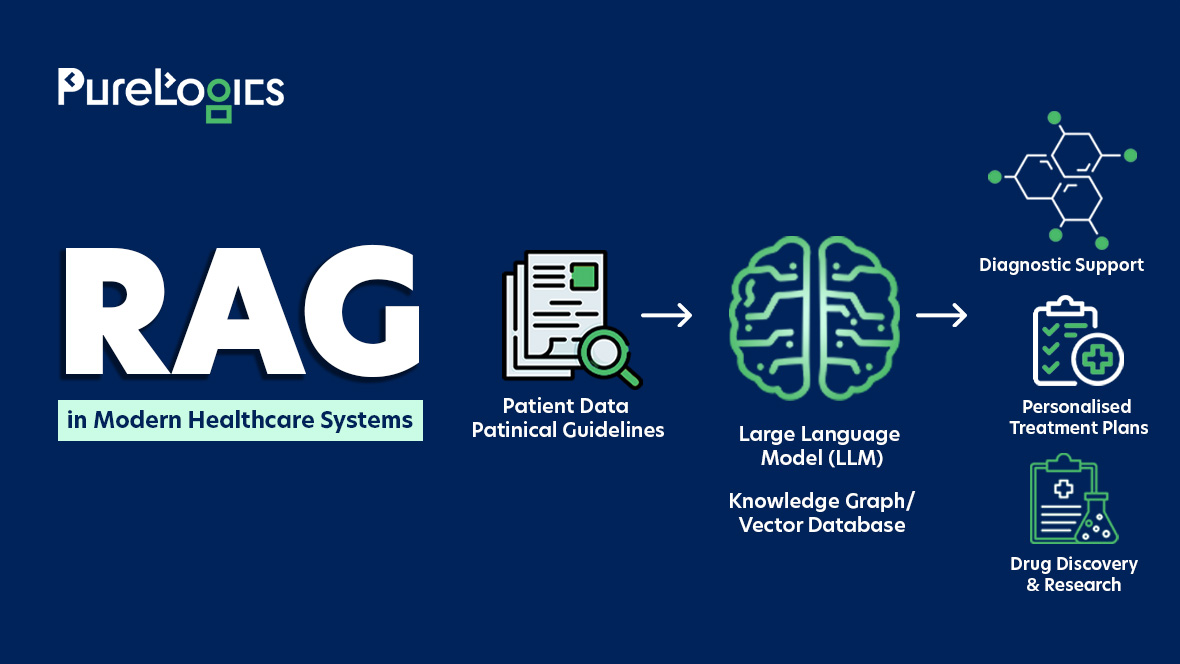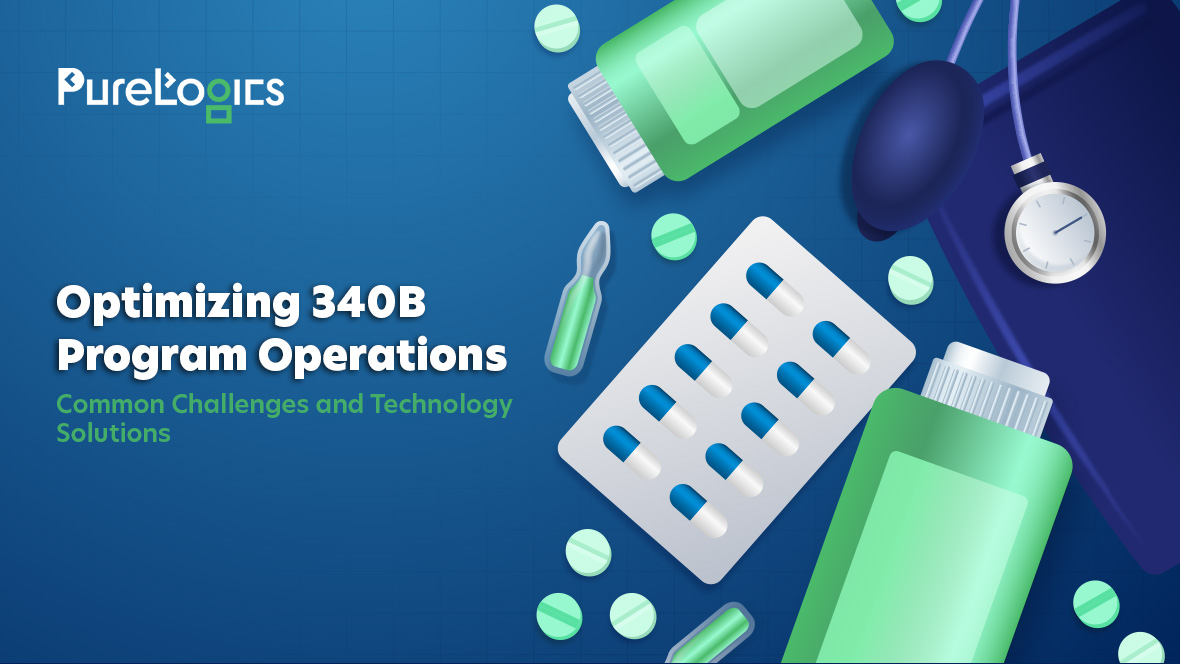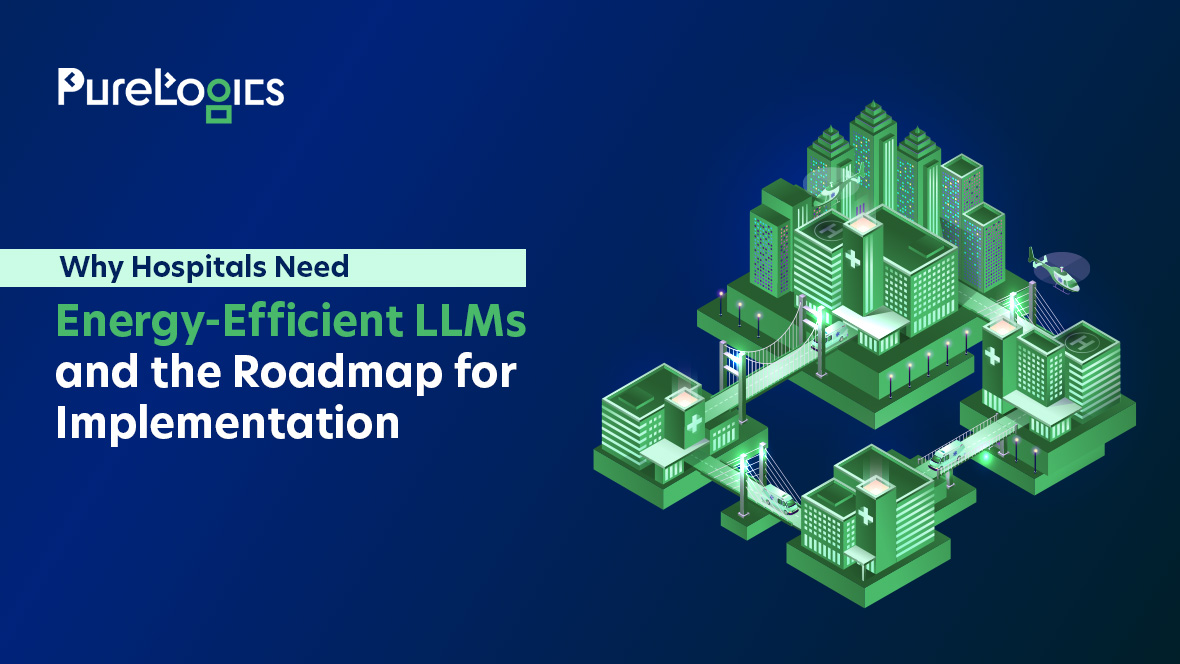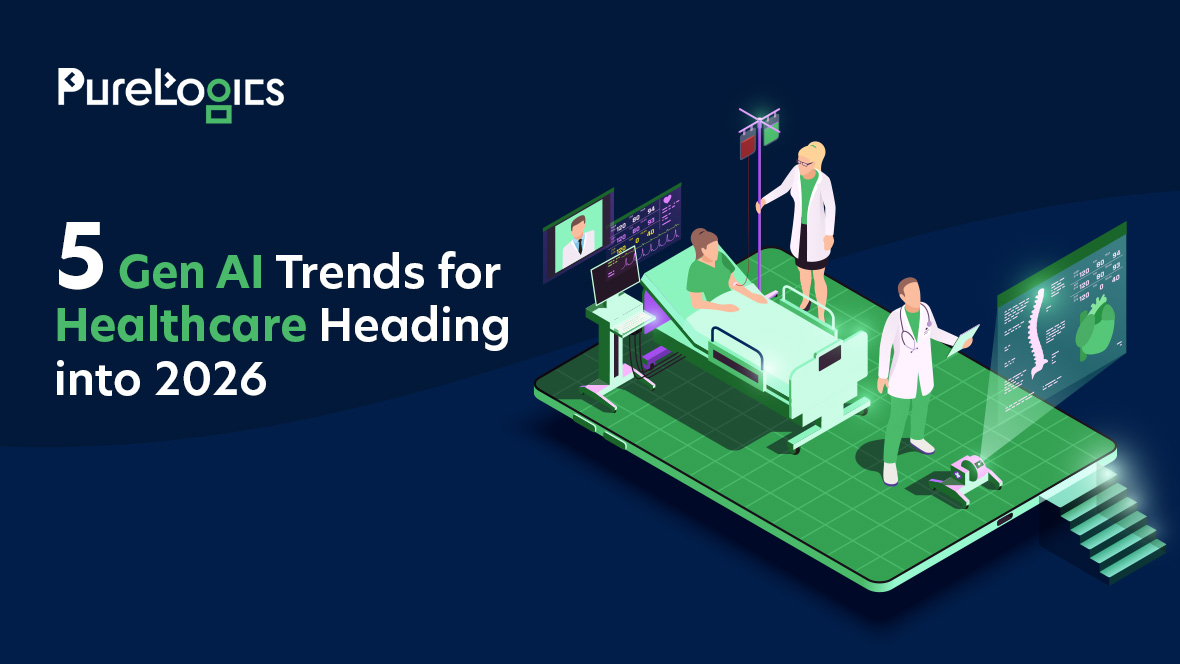Imagine Sara wearing a smartpatch, sitting at home and enjoying a good book, when suddenly her blood pressure levels drop. She has a condition of hypertension, and her physician receives an alert, connects with her, and takes prompt action. This was all possible due to the IoT technology integrated into her smart patch, which monitored and transferred data in real-time. This is just one example; currently, wearables and smart beds, in addition to multiple applications, have made IoT technology a necessity, not a luxury.
However, many healthcare providers face challenges in its correct implementation, so if you are among those. Then read this blog to know how IoT technology works and how you can integrate it into your existing systems. Once finished, you will know all about:
- What is IoT in healthcare, and how does it work?
- Its applications (from the patient, physician, and healthcare institution perspectives).
- IoT healthcare solutions trends (in case you are not a healthcare provider, just looking to build an IoT platform for business purposes).
- Steps for IoT implementation and challenges you can face.
Bonus: We are highlighting top-notch technologies used in the development of IoT solutions. First, let’s start with the global rise of the healthcare IoT market.
The Rise of the Global IoT Healthcare Solutions Market
IoT, with its extensive ability to allow real-time monitoring, faster diagnosis, and efficient resource management across healthcare settings, has become popular in the healthcare ecosystem. Over time, this technology is expected to continue expanding due to the increasing demand for personalization and remote monitoring. According to an estimate, the size of the IoMT market is expected to reach $814.28 billion by 2032. The US is expected to have the highest revenue in the healthcare IoT market.
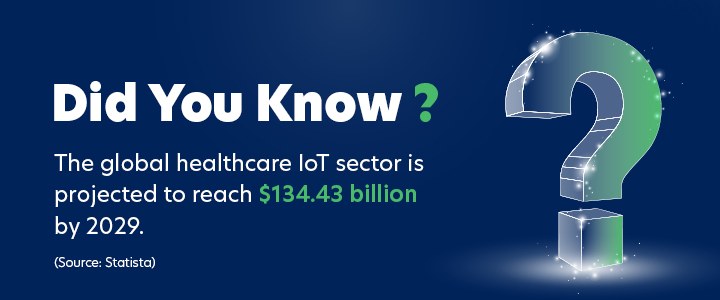
Including IoT, the other technologies serving the healthcare sector are AI, which brings automation and powers efficient diagnostics. Furthermore, other emerging technologies, such as augmented reality (AR), virtual reality, and blockchain, are making their due contributions to revolutionize the healthcare sector.
Together, these technologies are introducing greater efficiency, bestowing automation and accuracy, and building strong, more intelligent, and connected systems. Let us tell you about the other essential technologies that are equally facilitating the transformation of the healthcare field.
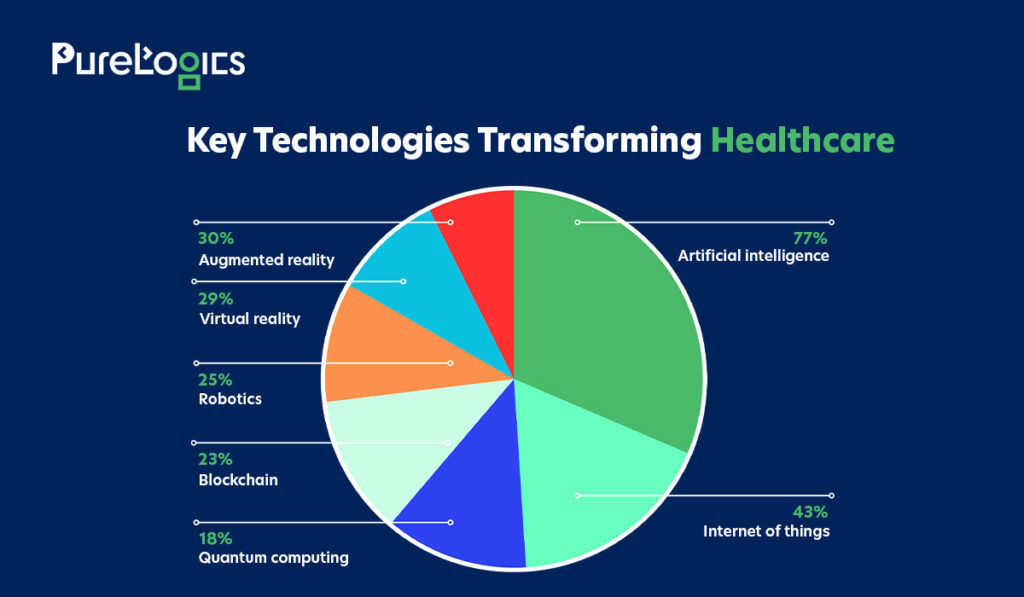
After AI, IoT is the most widely used technology in healthcare due to its ability to provide a real-time view of data, thereby strengthening the connection between providers and patients. This makes healthcare more personalized and responsive to patient needs.
However, you might still wonder why technologies like blockchain, which enhance healthcare security, or advanced robotics, which enable doctors to perform remote surgeries, are not ahead of IoT. The answer lies in the multiple advantages of IoT, which improve healthcare operations.
Benefits of IoT in Healthcare: The True Reason Behind the Rise
IoT in healthcare can facilitate data collection, health monitoring, and data access, ultimately improving patient care. This significantly decreases the burden on healthcare providers, as they can remotely track their patients’ health. Additionally, reducing patient visits allows doctors to remain productive. Furthermore, some of the advantages of IoT are given below:
- Real-Time Monitoring
IoT devices are crucial for continuously tracking patients’ vital signs, enabling faster and more effective responses.
- Enhanced Operational Efficiency
It automates routine tasks and enables real-time tracking of resources, allowing staff to work more efficiently and effectively.
- Remote Patient Care
IoT enables doctors to track their patients remotely, reducing hospital visits for patients and enhancing access to healthcare.
- Data-based Decisions
This technology collects data that allows doctors to make informed decisions.
- Early Detection
The IoT provides continuous data, which helps in the early detection of abnormalities, thereby preventing severe conditions from developing.
- Asset & Inventory Management
The smart sensors enable hospital staff to track equipment and medication, preventing both under- and over-stocking.
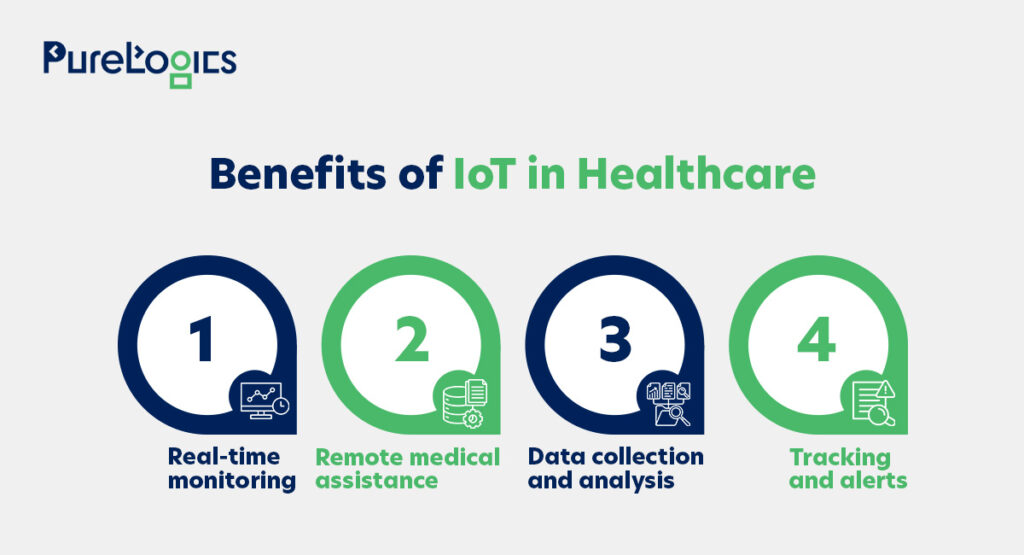
- Tracking and Alerts
IoT enables real-time tracking of vitals and provides instant alerts, allowing for timely action and ensuring better patient safety.
The IoT healthcare solutions have transformed the way care is delivered and managed, as they also assist medical staff in tracking assets through a network of smart devices and sensors. Behind this functionality lies a robust architecture, which we will explain in detail, along with a brief introduction to IoT in healthcare.
What is IoT in Healthcare?
IoT or Internet of Things in healthcare is a network of connected medical devices, sensors, software applications, and systems that collect, transfer, and analyze patient data. Enabling remote monitoring and analysis of data, leading to informed decision-making both within and outside traditional medical settings.
What are IoT Healthcare Solutions?
The Internet of Things (IoT) healthcare solutions are intelligent systems that utilize connected devices to enhance healthcare. Such as sensors, software, and cloud platforms to collect, monitor, and analyze health data in real-time. Contrary to popular belief, the IoT technology, beyond remote monitoring, can also aid in asset tracking and efficient monitoring of hospital environments, among other applications.
How does IoT work in Healthcare?
The IoT in healthcare operates through a multi-layered architecture, which represents a wireless or wired network of hardware that gathers environmental and equipment data. This also includes software that stores data in one place for efficient analysis and informed decision-making.
Therefore, healthcare IoT applications that facilitate remote monitoring and strategic planning of equipment operate through three key layers: the perception layer, also known as the device layer, the network layer, and the application layer.
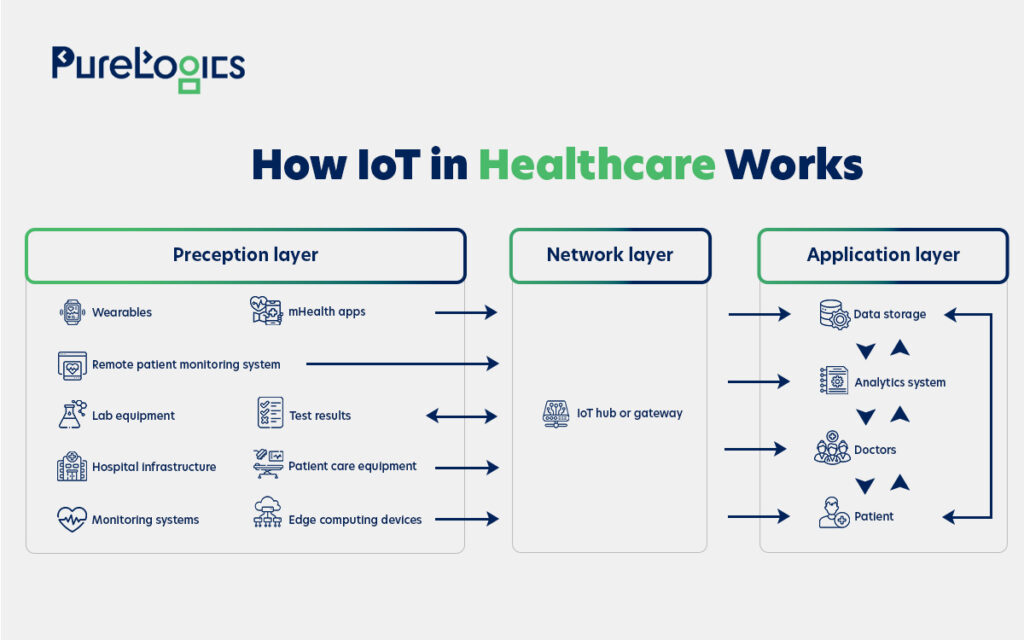
- Perception/ Device Layer
Medical-grade IoT devices encompass a range of products, including healthcare apps, mobile phones, smartwatches, lab equipment, and remote monitoring systems. Equipped with perception and identification technologies like radio frequency identification (RFID), GPS, and smart sensors that collect diverse types of data (from patients or environments). Furthermore, the IoT devices can be equipped with data analytics capabilities to analyze the data before sharing it.
- Network Layer
Another layer in IoT healthcare solutions is the network layer. This level is all about the transfer of data, which can occur through wireless or wired networks, utilizing various communication technologies, such as Bluetooth, WiFi, Zigbee, and global systems for mobile communications which facilitates the smooth transfer of data received from sensors or devices to data centers or clouds for further standardization and analysis.
- Application Layer
It includes data analytical systems, EHRs, repositories, and other software. This allows users to collect data efficiently, manage connected devices, create detailed medical records, and then analyze this data. Moreover, IoT devices can be integrated with AI to leverage deep learning capabilities, which enhances diagnostics.
The architecture of IoT healthcare solutions determines their efficient operation and practical value. Furthermore, the secure system of connected devices, efficient data flow, and real-time processing can help healthcare providers with remote monitoring, automated drug delivery, and a variety of other uses. If you are at all uncertain about how IoT can be applied to your systems, let us explain how.
IoT Applications For Your Healthcare Setup
This technology is opening doors to smarter and more connected healthcare operations, supporting proactive care. Medical IoT devices automatically collect health data, such as heart rate, blood pressure, and temperature, from patients remotely, which helps healthcare providers with treatment, analysis, and care. Some of the top applications are given below:
- Remote Patient Monitoring
The wearable devices track patients’ vital signs and alert healthcare providers to any potential issues. Here, the IoT serves as the backbone of the entire process, enabling real-time collection and exchange of healthcare data. This allows the doctors to monitor their patients remotely and make informed decisions.
- Medication Management
Medication management has become extremely easy with the help of IoT, as this technology ensures that patients take the right medicine at the right time. Furthermore, devices like pill dispensers and connected devices monitor dosage, send reminders, and alert nurses or doctors if a dose is missed. This helps prevent misuse, making the whole process safer.
- Asset Tracking
The RFID tags (a type of tracking system that uses intelligent barcodes to recognize items) and sensors help in tracking medical equipment. It enables hospitals to reduce waste and efficiently locate devices, also ensuring timely maintenance.
- Monitoring Environment
IoT sensors maintain the optimal conditions by tracking humidity, temperature, air quality, light levels, and room occupancy in hospitals or labs. This helps maintain a sterile environment and ensures patient safety.
- Robotic Surgery Assistance
Robotic surgeries enabled by IoT facilitate the exchange of real-time data between surgical tools, monitoring systems, and robots. This allows surgeons to receive instant feedback on patient vitals and device performance. This enhances safety, coordination, and precision in operating theaters.
- Smart Hospital Rooms
IoT devices installed in hospital rooms create a personalized and connected environment. Everything in these rooms is controlled by IoT systems, including real-time patient monitoring and nurse call systems, which help increase operational efficiency and effectiveness.
- Infection Control Systems
IoT healthcare solutions can help alert staff if cleaning protocols are missed or if there is a risk of contamination, which automatically reduces the spread of infections in hospitals. They can also detect air quality and hand sanitization compliance.
- Medical Equipment Maintenance
Another vital use of IoT, which helps hospitals save costs, is monitoring the performance, usage, and condition of medical equipment. This facilitates preventive maintenance and finds potential failures, reducing downtime.
- Connected Ambulances
IoT enables real-time communication between paramedics and hospitals, allowing vital patient data to be transmitted. This helps doctors prepare in advance, which speeds up treatment and saves critical time, ultimately improving the overall emergency response.
Due to its multiple uses, it can be challenging to distinguish the applications of IoT, especially for patients, hospitals, and physicians. These stakeholders are all part of the healthcare ecosystem, and their usage of this technology can vary. That’s why the IoT healthcare solutions for each one of them will have unique features.
IoT Healthcare Solutions for Hospitals vs. Patients vs. Physicians
The IoT in healthcare extends beyond technology, facilitating all parties involved, including hospitals, patients, and physicians. It enhances connectivity, optimizes operations, and enables physicians to stay connected with their patients at all times. Additionally, helping physicians and healthcare providers make quicker decisions enhances the overall quality of care, making the healthcare experience more responsive, and transforms how care is provided across the healthcare ecosystem at every level.
The Internet of Things medical devices, also commonly referred to as the Internet of Medical Things (IoMT), connect patients, doctors, and medical devices by transmitting information across secure networks, saving millions of lives and addressing challenges associated with rising costs and changing demographics. Let us tell you the uses of IoMT from the perspective of all stakeholders.
IoT for Patients
- This constant connectivity is beneficial for real-time tracking and early detection of health issues, advantageous for elderly citizens or those living alone, as any irregularity can send alerts to healthcare providers or family members, facilitating timely intervention. It is even helpful for remote diagnosis, creating a culture of proactive and patient-centered care.
- Its ability to track patients’ health metrics promotes greater patient involvement in their personal health decisions. Educated patients can make informed decisions about their health.
- IoT devices send alerts and reminders to patients for upcoming appointments, notifications for medication, or anomalies in healthcare data, helping the patients stay consistent with their treatment plans.
IoT for Physicians
- Wearables or home monitoring equipment (embedded with IoT) can help doctors track their patients’ health. It also allows doctors to check patients’ adherence to their health plans.
- The data gathered via IoT devices can help doctors analyze and determine the most effective treatment processes and procedures.
- IoT also helps physicians detect urgent health issues and respond immediately.
- This continuous flow of data enables physicians to make more informed decisions, leading to proactive, connected, and efficient care.
- Integrating seamlessly with electronic health records (EHR), the IoT devices allow physicians to access and enter data without manual intervention. Helping doctors do what they are meant to do, which is taking care of their patients.
- Physicians gain access to the latest patient healthcare data, enabling better collaboration with the care team, including nurses and therapists, which supports coordinated care.
- IoT systems now integrated with AI-powered analytics provide physicians with insights based on real-time patient data, promoting efficient care supported by real-time data.
IoT for Hospitals
- In addition to monitoring patient health, IoT devices have proven helpful in many areas for hospitals. The devices with sensors help track the real-time location of medical equipment (wheelchairs, defibrillators, oxygen pumps, nebulizers, and diagnostic machines). It is helpful in quickly finding and using equipment that enhances operational efficiency.
- IoT-based systems also monitor the movement and availability of medical staff, enabling efficient allocation of resources across departments.
- IoT devices have proven helpful in infection control, particularly in hygiene monitoring. Medical IoT devices help track compliance with sanitation protocols, decreasing the risk of hospital-acquired infections.
- Asset management, such as the maintenance of hospital and pharmaceutical supplies, is also one of the benefits of IoT for hospitals. Additionally, these devices regulate the temperature and humidity levels for sensitive medications and blood samples.
Another important stakeholder in the healthcare system that gives financial support to patients to access medical care is health insurance companies. The IoT healthcare solutions, which include real-time patient monitoring, medication management, and numerous other applications, are indeed vital for patients, hospitals, and physicians. Moreover, their multiple uses and widespread applications have also opened avenues for healthcare insurance companies.
IoT for Health Insurance Companies
IoT healthcare solutions present numerous opportunities, as follows:
- Health insurers with IoT capabilities can utilize the data gathered through health monitoring systems for their claims operations and underwriting.
- Data helps them detect fraud, ensuring transparency with their customers in both claim handling and risk assessment processes.
- Provides customers with visibility into their data, helping insurers and patients to be on the same page. Additionally, these devices help insurance companies validate their claims by capturing data.
Indeed, the range of features in IoT healthcare solutions, including asset management and patient monitoring, helps in streamlining healthcare operations, which is essential for maintaining the superior quality of care. Additionally, the technologies that can ensure smooth operations should be chosen after careful deliberation. That’s why we are providing a list of all the key technologies (databases, frontend, and backend) that contribute to the development of modern IoT healthcare solutions.
Key Technologies Used in IoT Healthcare Solutions
Building an IoT healthcare solution is all about developing a robust technology infrastructure that supports the solution’s user-friendliness, security, and top-notch performance. The front-end, backend technologies, and databases are given below.
Real-time Data Streaming
- Apache Kafka
- Apache Flink
- Apache Storm
- Spark Streaming
- Amazon Kinesis
- Google Cloud Dataflow
- Azure Stream Analytics
Data Lakes
- Amazon S3
- Azure Data Lake
- Apache Hadoop
- Apache Nifi
- MongoDB
Databases / Data Storage
- SQL Server
- MySQL
- PostgreSQL
- Oracle
- MongoDB
Cloud Databases / Data Storage
- AWS
- Google Cloud
- Azure
- IBM
- Oracle
- SAP
- DigitalOcean
- MongoDB Atlas
IoT Data Analytics
- Azure
- Amazon QuickSight
- Google Data Studio
- Power BI
- Tableau
- Qlik
- Sisense
- Apache Superset
- Grafana
Back End
- .NET
- Java
- Node.js
- PHP
- Go
Front End
- HTML
- CSS
- JavaScript
- Angular
- React
- Vue.js
- Next.js
The use of the right technology can help develop a strong architecture that enhances the functioning of the solutions. Plus supports innovation that can serve the healthcare sector well. If you are looking to create an IoT healthcare solution, then let us tell you about some of the key trends that are expected to persist in the coming years. You can build your IoT solution in line with these emerging trends and earn a significant amount of profit (if you are not a healthcare provider).
High-Demand IoT Healthcare Solutions You Can Develop
IoT technology is going nowhere in the healthcare world due to its multiple applications, so if you are interested in developing IoT solutions. You must be aware of the areas that are gaining traction, offering opportunities for growth and expansion.
- Personalized Care Solutions
These solutions help collect data, and the integration of AI enables doctors to develop personalized treatment plans. These AI-powered solutions are going to be highly popular in the digital healthcare ecosystem, as AI helps in interpreting patient data in real-time, thereby enhancing patient outcomes.
- Medical Equipment Software
There will be a high demand for software that utilizes IoT to track medical equipment; however, these solutions will become increasingly intelligent with the integration of AI. This will help identify equipment failures before they even occur, ensuring efficient and timely repairs.
- Remote Surgeries
Another innovative use of IoT will be in remote surgeries. The AI will process data from devices, enabling healthcare professionals to perform surgeries remotely, regardless of patient location.
We are also highlighting some key statistics regarding the growth of medical IoT devices.
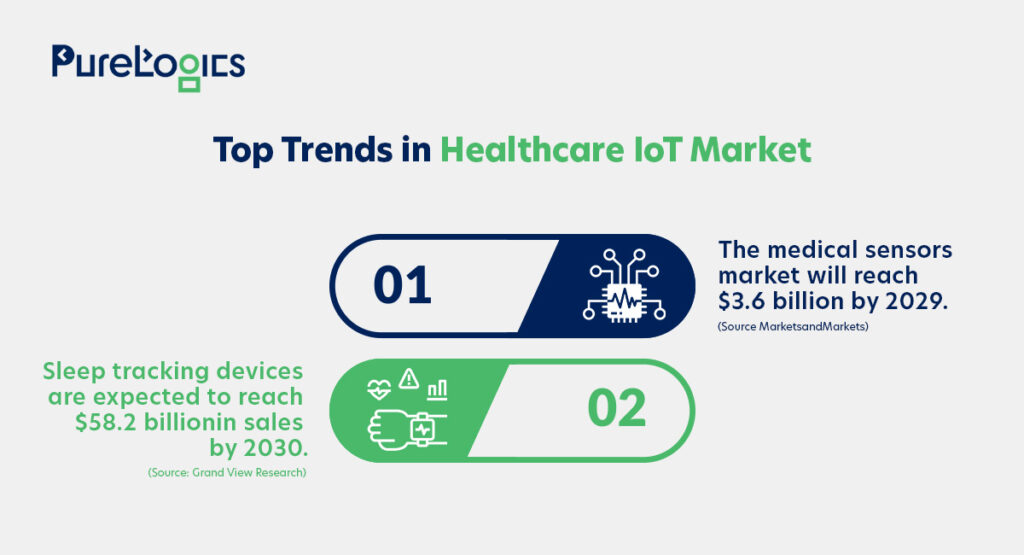
The IoT healthcare solutions have undoubtedly become popular due to their utility, but many healthcare providers are looking to integrate IoT into their systems. If you are one of them, then let us guide you through the steps on how to implement it in your existing healthcare system.
How to Integrate IoT in Medical Devices?
You can integrate IoT in your medical devices, but you might need the help of healthcare software development company for its correct implementation to reap its maximum benefits. Here’s an eight-step process for you:
- Determine Your Objectives
Identify your objectives and requirements, which essentially mean your aim or, in simple terms, what you are looking to achieve with IoT, such as improved patient monitoring, enhanced operational efficiency, and reduced hospital readmissions.
- Select the Right IoT Devices
Select the appropriate IoT devices based on your objectives, such as wearable monitors, smart beds, or remote patient monitoring systems. Here, remember to ensure that the selected devices are compatible with your existing healthcare systems.
- Build Your Data Management Strategy
Plan how your data will be gathered, stored, and analyzed. You can implement cloud solutions for secure data storage and use advanced analytics to get actionable insights from the collected data.
- Data Security & Compliance
Take measures such as encryption and multi-factor authentication to protect your patient data, and ensure that you regularly update and patch IoT devices. This will help prevent security breaches and protect patient data in compliance with data protection standards and rules.
- Invest in Infrastructure
Update your network infrastructure to handle the increased data traffic from IoT devices. This can include investing in advanced routers, high-speed internet, and 5G technology. You must select an IoT platform that supports device management, data analytics, and seamless integration. Some popular platforms are:
- AWS IoT
- Microsoft Azure IoT
- Google Cloud IoT
- Train Your Staff
Educate your staff on how to use IoT devices and interpret the data, this will require continuous training and support. You can provide them with user manuals and online tutorials to help them tackle any issues they might encounter.
- Testing
Test your IoT implementation by initiating a small-scale pilot project, tracking the results to gather feedback, and making necessary adjustments. When testing, ensure that your infrastructure is equipped to handle increased load and maintain optimal performance.
- Continuous Monitoring
For continuous data flow, the healthcare IoT devices must perform reliably and securely over time. Ongoing monitoring and tracking of IoT healthcare solutions and systems can help you detect issues, ensure consistent operation, and minimize downtime.
IoT Healthcare Solution Implementation Challenges
The IoT implementation comes with several challenges despite its immense potential. You may encounter issues such as data security concerns, adoption challenges, and high upfront costs. Some of the other challenges you can face are:
- Data Flow
The IoT devices offer a large amount of data each day, which can overwhelm the healthcare providers. However, any healthcare software development company can develop software that can help filter massive amounts of data. Features like real-time dashboards and alerts can provide more precise and real-time views to assist doctors in making informed decisions.
- Deployment Issues
Deploying IoT healthcare solutions or IoT devices can be difficult due to compatibility issues with existing systems. Additionally, another major hurdle can be stability and data security; moreover, scaling and managing large numbers of devices can also pose challenges.
- Security
IoT devices are complex to protect, as they often lack built-in security. Healthcare providers are also required by law to safeguard patient health information. Moreover, the unsecured data transmission can lead to breaches of sensitive patient data, also increasing the risk of exploitation.
- Cost
Developing IoT healthcare solutions involves multiple factors, including platform support, third-party integrations, compliance, security, data assortment, and analysis. Furthermore, prototyping, testing, and the complex architecture can further increase the cost, ranging from $50,000 to over $200,000 for a feature-rich and multi-platform IoT ecosystem. The best strategy here is to develop an MVP with the necessary features, and then scale according to your expansion needs over time.
Turn Healthcare IoT Challenges into Opportunities with PureLogics
If you are facing IoT integration challenges or looking to develop customized IoT solutions, PureLogics, with nearly two decades of experience, can help you. So, avoid compromising patient care and provider efficiency. Simply contact us to get a secure, seamless, and scalable solution. Our healthcare software developers are recognized in the industry for delivering innovative IoT healthcare solutions that facilitate efficient asset management, remote patient monitoring, and other key functionalities. You can view our projects here.
FAQs
1. What is the IoT in healthcare?
IoT in healthcare refers to the networks of connected devices such as sensors, software, and cloud platforms that help in monitoring and transferring real-time data. This is just one everyday use of IoT; other than this, the technology is used in:
- Hospital equipment management
- Medication management
- Optimization of resource allocation operational workflows.
2. What are the five examples of IoT used in healthcare?
IoT has multiple applications in healthcare, and the top ones are given below for you to view:
- Medication dispensers
- Smart Inhalers
- Remote sensors
- Smart beds
- Connected implants
3. What is the future of healthcare in IoT?
The future of IoT in healthcare is promising, driven by advancements in wearable technology and the emergence of smart hospitals. More innovations are expected to be witnessed, especially with the integration of AI, machine learning, and predictive analytics.
4. What is the use of IoT in hospitals?
IoT in hospitals is used to monitor patient health in real time, track medical equipment, and bring efficiency to operations. This helps increase patient safety, enhances clinical decision-making, and improves overall care delivery efficiency.

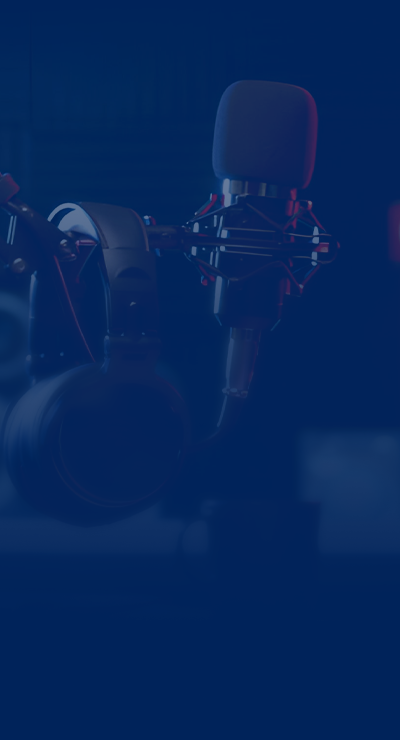
 [tta_listen_btn]
[tta_listen_btn]
 June 30 2025
June 30 2025

